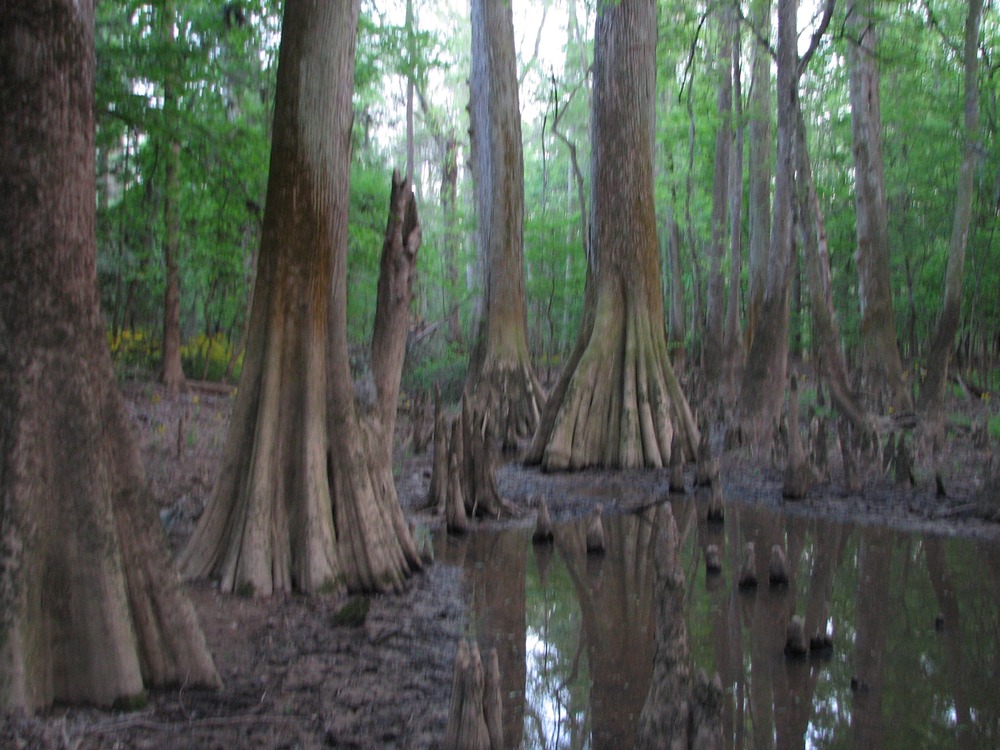Want to break away from the hustle and bustle? Congaree National Park is the place for you! Here, you can do many activities. Plus, observe the abundant wildlife and plants. Immerse yourself in the grand outdoors. See how this national park can give you an exceptional vacation!
Introduction
Congaree National Park, nestled in the heart of South Carolina, is an enchanting haven for nature lovers and adventurers alike. Dappled sunlight filters through the towering cathedral-like trees, some reaching 150 feet high. Ferns, wildflowers, and a rich diversity of animal and plant life create an intricate ecosystem.
During periods of heavy rainfall, the Congaree River overflows, transforming the landscape into a breathtaking mosaic of swamp and marshland. Cypress knees protrude from the water’s surface, and vibrant water lilies adorn still ponds.
To explore this untamed wilderness, embark on one of the park’s many hiking trails or paddle along its meandering waterways. Keep your eyes peeled for wildlife such as river otters, armadillos, and the iconic barred owl.
Conquer your fear of missing out by embarking on an unforgettable adventure at Congaree National Park. Feel the serene stillness wash over you as you become one with nature and forge memories that will last a lifetime.
Location and History
Congaree National Park is situated in South Carolina and boasts a rich history and variety of ecosystems. Visitors can explore its spectacular natural beauty and discover its amazing history.
Park Information
| Location | South Carolina |
|---|---|
| Size | Over 27,000 acres |
| Established | November 10, 2003 |
| Significance | Protects one of the largest intact expanses of bottomland hardwood forest |
| Visitors | More than 150,000 annually |
Congaree National Park was formed to protect one of the greatest remaining expanses of old-growth bottomland hardwood forest in the U.S. Plus, the park is home to lots of wildlife, like otters, deer, and even endangered species such as the red-cockaded woodpecker.
Don’t miss out on this fantastic experience! Whether you’re into hiking or observing rare flora and fauna, Congaree National Park has something for everyone. Don’t hesitate – plan your visit today and see the gigantic trees for yourself!
Geography
Congaree National Park is situated in South Carolina, spanning over 26,000 acres of land. It features an array of unique natural features, with its elevation ranging from 50 to 175 feet above sea level. The Congaree and Wateree Rivers flow through the park, and it is also home to one of the largest expanses of old-growth bottomland hardwood forests in the southeastern United States. This ecosystem is a haven for rare and endangered species of plants and animals.
For a truly captivating experience, consider the following when visiting:
- Take a guided tour. A knowledgeable ranger can provide valuable insights into the park’s geography and ecosystem.
- Explore hiking trails. Comfortable footwear and plenty of water is necessary to enjoy the scenery.
- Attend educational programs. Lectures and workshops offer a chance to engage with experts and learn more about the park.
So, come to Congaree National Park and sweat out your worries while admiring its stunning geography and natural wonders!
Climate
At Congaree National Park, experience a wild climate all year long. Summer is hot and humid – up to 100 degrees Fahrenheit – whilst winter is more mild, at around 50F. It also gets lots of rain, which helps its lush, vibrant ecosystem.
This diverse climate shapes the park’s unique biodiversity. The heat, humidity, and rain create the perfect home for various plants and animals. Plus, the towering cypress trees provide shelter for birds, reptiles and mammals.
Explore Congaree National Park in any season and discover its ever-changing beauty. From the vivid colors of autumn to the summer night’s insect chorus, you’ll never get bored. So come and immerse yourself in this incredible environment and create memories that will last forever.
Flora and Fauna
Congaree National Park is home to a stunning variety of flora and fauna. Trees such as Cypress and Tupelo Gum provide shade and shelter for birds like woodpeckers and warblers. Shrubs like sweetbay and wax myrtle dot the landscape.
Furry visitors include white-tailed deer, otter, fox squirrel, and raccoon. The park’s wetlands attract herons, egrets, and more. Reptiles such as alligators, turtles, and the Carolina pygmy rattlesnake are found there. Amphibians like frogs and salamanders also thrive in this unique habitat.
An inspiring tale of the park’s wonders is the discovery of a rare warbler species, thought to be extinct. This serves as a reminder of the importance of Congaree National Park’s preservation of endangered wildlife.
Exploring Congaree National Park is an unforgettable experience. It’s an incredible natural wonderland that will make the Amazon rainforest look like a bunch of houseplants!
Ecosystem
The Congaree National Park is a home to a vibrant and complex ecosystem. It has many habitats that create a good environment for multiple species of plants and animals to thrive. Here’s an overview of it:
Ecosystem:
- Forest Types: This park is full of several types of forests, such as bottomland hardwood, pine, and swamp forests. Every forest has its own set of flora and fauna.
- Biodiversity: The park is known for its abundance of biodiversity. It has around 600 plant species, plus towering trees such as Bald Cypress and Tupelo. Animals also live here.
- Wetlands: The wetlands are important for the ecosystem. They provide a home for many aquatic life forms, like fish and amphibians.
We must protect the balance in the Congaree National Park’s ecosystem. Here are a few ways to do this:
- Respect Wildlife: Keep your distance from animals. Don’t feed or disturb them.
- Leave No Trace: When you visit, be aware of your impact on the environment. Take all trash with you. Don’t disturb vegetation.
- Support Conservation Efforts: Donate or volunteer for organizations that preserve parks like Congaree. This helps to protect the valuable ecosystem for future generations.
By following these tips and spreading awareness about environmental responsibility, we can ensure that the delicate ecosystem at Congaree stays intact. Let’s binge-save the habitat!
Conservation
Conservation is essential for preserving Congaree National Park’s natural beauty and biodiversity. It focuses on protecting unique ecosystems, like its ancient forests and wildlife.
To ensure the park’s sustainability, research and monitoring are done to understand the ecological needs and threats of species. This helps scientists create effective conservation strategies that help the survival of these delicate ecosystems.
Habitat restoration projects are also done. Their purpose is to restore damaged areas, allowing native species to grow and boosting biodiversity. Planning and implementation contribute to a healthier ecosystem and a brighter future for the park’s flora and fauna.
Congaree National Park was awarded the prestigious recognition of International Biosphere Reserve by UNESCO in 1983. This illustrates how preservation can unite nations in protecting our planet’s heritage.
Who needs a fitness app when you can hike through Congaree National Park and get lost both physically and emotionally?
Recreation
Congaree National Park is a hidden gem in South Carolina’s backyard, offering an array of recreational activities for outdoor adventurers. From hiking along scenic trails to kayaking through serene waterways, there are options for every thrill-seeker. This unique park also boasts the largest intact expanse of old-growth bottomland hardwood forest in the Southeast, providing a habitat for diverse wildlife species and a haven for birdwatchers.
Make the most out of your visit! Take advantage of the park’s guided tours and ranger programs to gain educational insights into its natural wonders. Plus, plan your trip during spring or autumn when temperatures are mild and the scenery is breathtaking. Don’t forget to bring insect repellent and wear the right clothing for a comfortable experience in nature.
Congaree National Park guarantees an unforgettable experience for all outdoor enthusiasts. So, get ready to explore the beauty of this amazing park!
Tourism
Congaree National Park is an awesome spot for the travel-inclined! There’s heaps of stuff to do – go hiking through the green trails, canoeing in pretty rivers, and even spot some wildlife in the dense forests. You can experience nature’s glory and discover the many different plants and animals living in Congaree.
It’s special too! It’s 27,000 acres of old-growth bottomland hardwood forest – the biggest like this in North America! Plus, the trees are huge – up to 160 feet tall! And it’s an UNESCO Biosphere Reserve and International Dark Sky Park – you’ll see the night sky like nowhere else!
Visiting Congaree is more than just a sightseeing trip. You can join educational programs and guided tours to learn about conservation and protecting the unique ecosystems for future generations.
And who knows? With rising sea levels, next time you visit you might need waterproof boots and a paddleboard!
Future
The future of Congaree National Park is full of possibilities. A peek at what lies ahead for this amazing park is in the table below. It shows off various projects to upgrade the visitor experience, protect biodiversity, and promote sustainability.
Initiative
Description
Expansion of hiking trails
Add new trails to display hidden gems
Educational programs
Create engaging programs for all ages
Wildlife conservation efforts
Take measures to protect wildlife
Improved visitor facilities
Upgrade restrooms, picnic areas, and visitor centers
Sustainable practices
Push for energy and waste management
Congaree National Park has a long-standing dedication to environmental preservation. It’s been a refuge for many ecosystems since 1976 when it was established as a national monument and gained national park status in 2003.
Congaree National Park is focused on conserving its natural beauty while providing a great experience to all visitors. It’s looking towards the future with innovation and sustainability in mind.
FAQ
What is Congaree National Park known for?
Congaree National Park is known for its old-growth bottomland hardwood forest, diverse wildlife, and unique floodplain ecosystem.
How large is Congaree National Park?
Congaree National Park covers an area of approximately 26,276 acres.
What activities can visitors enjoy at Congaree National Park?
Visitors can enjoy activities such as hiking, canoeing, kayaking, camping, fishing, bird watching, and ranger-guided programs.
Are there any guided tours available in Congaree National Park?
Yes, Congaree National Park offers free guided tours led by park rangers. These tours provide valuable insights into the park’s history, ecology, and wildlife.
Is camping allowed in Congaree National Park?
Yes, camping is allowed in designated areas of Congaree National Park. There are primitive campsites available for visitors who want to spend the night in the park.
What is the best time to visit Congaree National Park?
The best time to visit Congaree National Park is during the spring and fall seasons when the weather is mild, and the park’s wildlife and foliage are particularly vibrant.




Leave a Reply